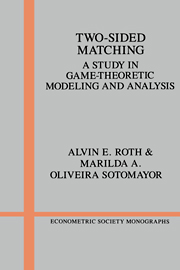Part I - One-to-one Matching: the Marriage Model
Published online by Cambridge University Press: 05 January 2013
Summary
In these chapters we will examine in detail the two-sided matching market without money that arises when each agent may be matched with (at most) one agent of the opposite set. For obvious reasons this model is, somewhat playfully, often called a "marriage market," with the two sets of agents being referred to as "men" and "women" instead of students and colleges, firms and workers, or physicians and hospitals. We will follow this practice here. In this whimsical vein, it may be helpful to think of the men and women as being the eligible marriage candidates in some small and isolated village.
The marriage market will be simpler to describe and investigate than a labor market in which a firm may employ many workers. And we will see in Part II that many (although not all) of the conclusions reached about this model will also apply to the hospital intern market, in which a hospital, of course, typically employs many interns. The marriage market will therefore be a good model with which to begin the mathematical investigation. In some of the discussion that follows, it will nevertheless be helpful to remember that much of our interest in this problem is motivated by labor markets, rather than by marriage in its full human complexity. (Thus we will sometimes speak about courtship, but never about dependent children or mid-life crises.)
- Type
- Chapter
- Information
- Two-Sided MatchingA Study in Game-Theoretic Modeling and Analysis, pp. 15 - 16Publisher: Cambridge University PressPrint publication year: 1990
- 2
- Cited by



